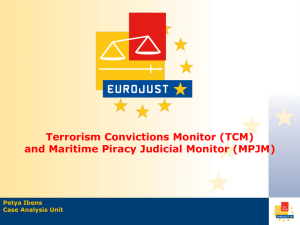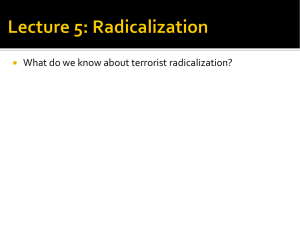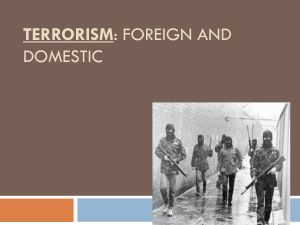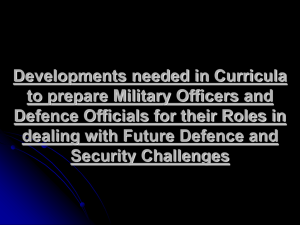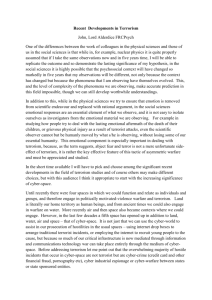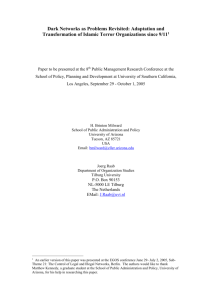Report - egmun
advertisement
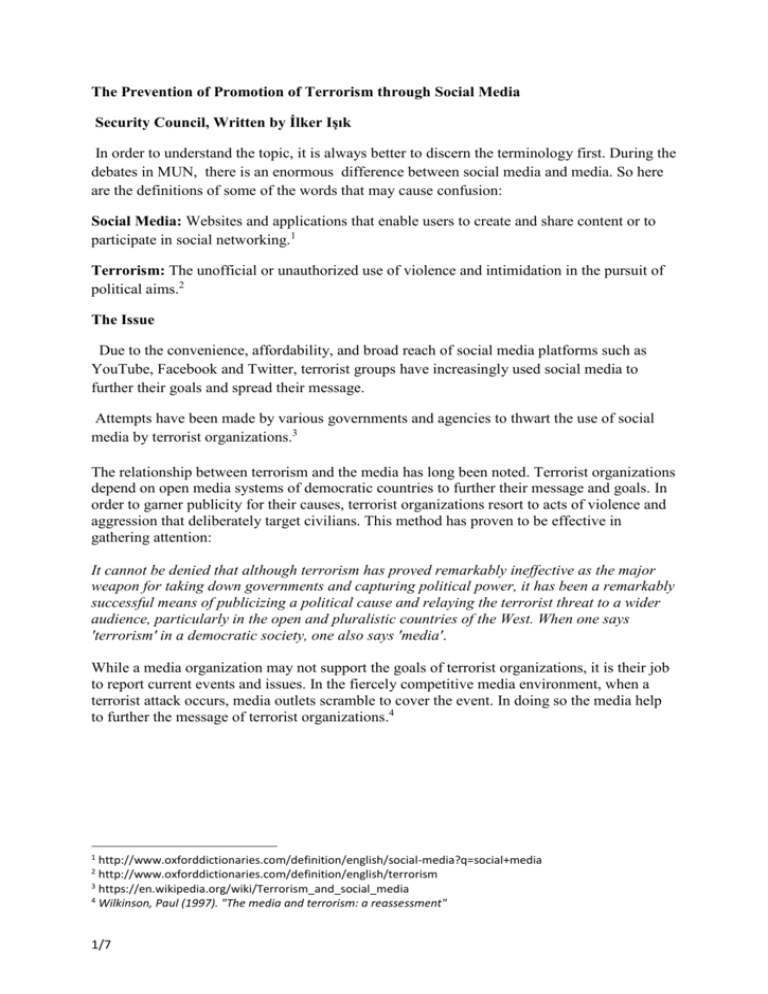
The Prevention of Promotion of Terrorism through Social Media Security Council, Written by İlker Işık In order to understand the topic, it is always better to discern the terminology first. During the debates in MUN, there is an enormous difference between social media and media. So here are the definitions of some of the words that may cause confusion: Social Media: Websites and applications that enable users to create and share content or to participate in social networking.1 Terrorism: The unofficial or unauthorized use of violence and intimidation in the pursuit of political aims.2 The Issue Due to the convenience, affordability, and broad reach of social media platforms such as YouTube, Facebook and Twitter, terrorist groups have increasingly used social media to further their goals and spread their message. Attempts have been made by various governments and agencies to thwart the use of social media by terrorist organizations.3 The relationship between terrorism and the media has long been noted. Terrorist organizations depend on open media systems of democratic countries to further their message and goals. In order to garner publicity for their causes, terrorist organizations resort to acts of violence and aggression that deliberately target civilians. This method has proven to be effective in gathering attention: It cannot be denied that although terrorism has proved remarkably ineffective as the major weapon for taking down governments and capturing political power, it has been a remarkably successful means of publicizing a political cause and relaying the terrorist threat to a wider audience, particularly in the open and pluralistic countries of the West. When one says 'terrorism' in a democratic society, one also says 'media'. While a media organization may not support the goals of terrorist organizations, it is their job to report current events and issues. In the fiercely competitive media environment, when a terrorist attack occurs, media outlets scramble to cover the event. In doing so the media help to further the message of terrorist organizations.4 1 http://www.oxforddictionaries.com/definition/english/social-media?q=social+media http://www.oxforddictionaries.com/definition/english/terrorism 3 https://en.wikipedia.org/wiki/Terrorism_and_social_media 4 Wilkinson, Paul (1997). "The media and terrorism: a reassessment" 2 1/7 Countries with Large Presence of Terrorism 5 Terrorists have long found refuge in countries and, in many cases, have worked hand in hand with the local governments. Today some countries continue to attract terrorists and extremists for training and conspiring to commit attacks. The host countries do not try to disassociate themselves fully from their ties to terrorism, and in some cases continue to provide tacit support and use terror to accomplish broader objectives. Some of the countries with significant terrorist operations include: Afghanistan Afghanistan became the hotbed of Islamic terror activities in the mid-1990s. With the radical Taliban government establishing control, several radical Islamic (mostly Sunni) terror organizations used Afghanistan as their training and operational base. Al Qaeda was the broad umbrella organization that recruited terrorists from Pakistan, Afghanistan, Central Asia and around the world, training them in Afghanistan and Pakistan. Some of the terrorist groups still operating in the region include Al Qaeda, Al-Jihad, Lashkar-i-Jhangvi, Islamic Group, Armed Islamic Group, Harkat-ul-Mujahideen and the Islamic Movement of Uzbekistan. Iran Iran has long been an active sponsor of Islamic terrorism, including accusations of it supporting subversive activities in Iraq. Islamic Revolutionary Guard Corps and Ministry of Intelligence and Security were involved in the planning of and support for terrorist acts and continued to exhort a variety of groups that use terrorism to pursue their goals. Several terrorist groups including Lebanese Hizballah, HAMAS, the Palestine Islamic Jihad, and Ahmad Jibril's PFLP-GC have been provided funding, safe haven, training, and weapons in Iran. Iraq Since the US led invasion of Iraq, the country has fallen into a violent spiral. The presence of US troops has attracted Islamic terrorists from the Middle-East and around the world. AlQaeda is believed to have established a toe-hold in the country along with various splinter groups. Some of the other terror organizations active in Iraq include Ansar al-Islam, Al-Faruq Brigades, Al-Mahdi Army, Iraqi Resistance Islamic Front (JAMI), Jamaat al-Tawhid wa'lJihad, Jaysh Muhammad and Kurdistan People’s Congress (KHK). Pakistan Pakistan has long been a staging ground and planning centre for Islamic terrorists operating in South Asia. After the launch of Operation Enduring Freedom, thousands of terrorists were either killed or driven out of Afghanistan, mostly finding refuge in Pakistan. Pakistan and its secret service (ISI) have also been accused of training and funding several terrorist groups 5 http://www.terrorism-research.com/state/countries.php 2/7 operating in Indian Kashmir and the terrorist attacks in Mumbai. The links have long been clear, since the terrorist groups based in Pakistan operate in plain sight and have a distinct Afghan and Indian focus. The massive leak of U.S. Intelligence data on the Wiki leaks website further showed the complicity of the Pakistani state with terrorist groups, used to establish a (false) state of deniability. New York Times journalist Carlotta Gall has written a book that further delves into the Pakistani state's deep involvement with terrorism in Afghanistan. The former Canadian ambassador to Afghanistan and minister, Chris Alexander has made a similar assertion calling Pakistan a state sponsor of terrorism. Pakistani groups have been aligned with Al Qaeda, based in Pakistan and have been responsible for numerous terrorist attacks in Afghanistan and have expanded their sights to Europe and North America. Some of these terror groups include Lashkar-e-Taiba, Jaish-eMuhammad, Lashkar-e-Jhangvi, Al Qaeda, Tehreek-e-Jaferia, Sipah-e-Sahaba, Al Badr, Harkat ul-Ansar, Hizb-ul-Mujahideen, Tehreek-e-Nafaz-e-Shariat-e-Mohammadi, Jamaat ulFuqra and Muslim United Army. Syria Even as Syria continues to reduce its presence in Lebanon, it also continues to fund and host Palestinian and possibly Iraqi terrorist organizations. HAMAS, the PIJ, the Popular Front for the Liberation of Palestine-General Command, and the Popular Front for the Liberation of Palestine are some of the Islamic extremists that continue to operate from Syria. Syria has now become the hub of terror, where Islamic fundamentalist terrorists from Europe, Asia and the Middle-East are fighting the Assad regime to wrest control of the country. Sudan The African country of Sudan been a training hub and safe haven for members of several of the more violent international terrorist and radical Islamic groups of the last decade. Among the terror groups known to have operated from Sudan are Hezbollah (Party of God), Palestine Islamic Jihad, Abu Nidal Organization, HAMAS (Islamic Resistance Movement) and several smaller Islamic insurgent groups operating regionally in Ethiopia, Eritrea, Uganda, and Tunisia spreading extremism and killing innocent people based on religion and as part of criminal activities.6 6 http://www.terrorism-research.com/state/countries.php 3/7 Brief Timeline of Terror Attacks July 25, 1995, France: A bombing at the Saint-Michel subway station in Paris kills eight and injures more than 150 people. The attack is masterminded by Rachid Ramda, an Algerian with links to the Armed Islamic Group, a fundamentalist revolutionary group committed to overthrowing the Algerian government. Sept. 11, 2001, U.S.: The September 11 terrorist attacks kill nearly 3,000 people. Terrorists crash passenger jets into the Twin Towers of the World Trade Center in Manhattan and the Pentagon in Virginia, and a fourth airplane crashes in a western Pennsylvania field. March 11, 2004, Spain: A series of bomb blasts tears through four Spanish commuter trains in Madrid, killing more than 190 people, in the deadliest terror attack in Europe since Pan Am Flight 103 blew up over Lockerbie, Scotland, in 1988. An Islamist group said to have been inspired by al Qaeda is blamed for the attack. Nov. 2, 2004, The Netherlands: Dutch filmmaker Theo van Gogh is shot, stabbed and slashed across the throat by Dutch-Moroccan Muslim Mohammed Bouyeri, who is outraged by his victim’s criticism of Islam. (Mr. van Gogh’s short film “Submission: Part I” contained images of women’s bodies that had been imprinted with passages from the Quran.) A violent backlash ensues days after the killing, leading to a 15-hour standoff between police and members of a suspected terror cell in The Hague. July 7, 2005, U.K.: Four coordinated attacks by suicide bombers rip through London subway trains and a bus, killing 52 rush-hour commuters. The killers are later identified as British al Qaeda sympathizers Shehzad Tanweer, Hasib Hussain, Mohammed Sidique Khan and Jermaine Lindsay. 2005-2010, Denmark: The Danish newspaper Jyllands-Posten printed cartoons depicting the Prophet Muhammad in the autumn of 2005, sparking a jihadist campaign against Denmark. Jyllands-Posten, along with other Danish newspapers, reprinted the cartoons in 2008 as a message in support of freedom of speech. The drawings, including one by cartoonist Kurt Westergaard that featured Muhammad with a turban in the shape of a bomb, provoked outrage and protests across the Muslim world. After their publication, a plot to murder Mr. Westergaard emerged, and a suicide bombing rocked the Danish Embassy in Islamabad, Pakistan. In late 2010, Danish and Swedish authorities said they foiled a terrorist attack modeled on the Mumbai raid that had targeted the Copenhagen offices of Jyllands-Posten. Nov. 2, 2011, France: A fire started by a Molotov cocktail guts the Paris offices of Charlie Hebdo, hours before a special issue of the weekly that featured a caricature of the Prophet Muhammad appears on newsstands. No one is injured in the blaze. March 2012, France: Mohamed Merah, a French petty criminal swearing fealty to al Qaeda, kills three Jewish schoolchildren, a rabbi and three French soldiers in a series of point-blank shootings in and around the southern town of Toulouse. 4/7 May 22, 2013, U.K.: British-born Muslim converts Michael Adebolajo and Michael Adebowale drive into British soldier Lee Rigby outside a London army barracks, then stab him and tried to hack his head off with a meat cleaver. The two are filmed by passersby as they declare their actions to be in retribution for British military actions abroad. May 24, 2014, Belgium: A gunman murders four people at the Jewish Museum of Belgium in Brussels. Mehdi Nemmouche, a French national with ties to Islamic State, is arrested and charged with the killings. Oct. 22, 2014, Canada: Troopers stationed near Canada’s Parliament come under fire from Michael Zehaf-Bibeau, an ex-convict who weeks earlier had been thwarted in his attempts to fly to Syria and join Islamic State. After wounding an army reservist who later died in the hospital, Mr. Zehaf-Bibeau is shot by police and is pronounced dead at the scene. The assault is the first on Canada’s Parliament since Joseph Chartier’s 1966 bomb attack. Dec. 15, 2014, Australia: A 16-hour siege of a Sydney cafe ends with three people dead, including lone gunman Man Haron Monis, an Iranian immigrant who claims to be a recent adherent to the cause of Islamic State. After fruitless negotiations, police storm the scene. In the ensuing raid, Mr. Monis and two hostages—a 34-year-old man and a 38-year-old woman—are killed. 7 Previous Attempts to Deal With the Issue The General Assembly has been constantly adapting conventions, treaties, and resolutions to stop and prevent terrorism. Conventions such as suppressing the financing of terrorism, preventing nuclear terrorism, and so on have been adopted by the GA. However, these conventions and treaties are very difficult to enforce. You can find more information about attempts to resolve the issue at: https://www.cia.gov/search?q=terrorism&site=CIA&output=xml_no_dtd&client=CIA&myA ction=/search&proxystylesheet=CIA&submitMethod=get&ie=UTF8&ulang=en&ip=85.101.141.55&access=p&sort=date:D:L:d1&entqr=3&entqrm=0&wc=2 00&wc_mc=1&oe=UTF-8&ud=1&start=10 7 http://www.wsj.com/articles/timeline-of-terror-attacks-in-past-20-years-1420662841 5/7 Possible Solutions Before proceeding with the solution, what a delegate must do in the first place is to define terrorism. People that are classified as terrorists by the western nations are freedom fighters from their point of view.What causes someone to become a terrorist? Most of terrorism movements are done in the name of Islam, but why? Can our perception of terrorism be a misconception? These are the important questions that need to be answered before coming up with a definition and never forget that dictionary definitions usually doesn't include national claims. A possible solution would most probably include conventions with influential social network sites, such as Facebook, Twitter and YouTube. What shouldn't be forgotten is the 19th article in the universal declaration of human rights: "Everyone has the right to freedom of opinion and expression; this right includes freedom to hold opinions without interference and to seek, receive and impart information and ideas through any media and regardless of frontiers." One of the most important things to remember is that the terror acts are being done because of an ideology. An ideology cannot be killed, but it can be countered. Developing counterideologies and using them somehow to change the opinion of public may help to solve the issue as well, because rather than closing the eyes of the people we can show them the righteous side. Read more http://www.wsj.com/articles/timeline-of-terror-attacks-in-past-20-years-1420662841 http://isemodelunitednations2015.wikispaces.com/file/view/GA6Eliminate+international+Terrorism.pdf http://www.terrorism-research.com/state/countries.php http://www.cpsglobal.org/solutiontoterrorism http://www.un.org/en/documents/udhr/ http://www.un.org/en/ga/search/view_doc.asp?symbol=A/RES/68/187 http://www.un.org/en/ga/search/view_doc.asp?symbol=A/RES/68/178 http://www.un.org/en/ga/search/view_doc.asp?symbol=A/RES/68/119 http://www.theguardian.com/media/2015/aug/01/media-coverage-terrorism-further-violence 6/7 https://en.wikipedia.org/wiki/Terrorism_and_social_media http://www.e-ir.info/2012/07/22/terrorism-and-the-media-a-dangerous-symbiosis/ 7/7


